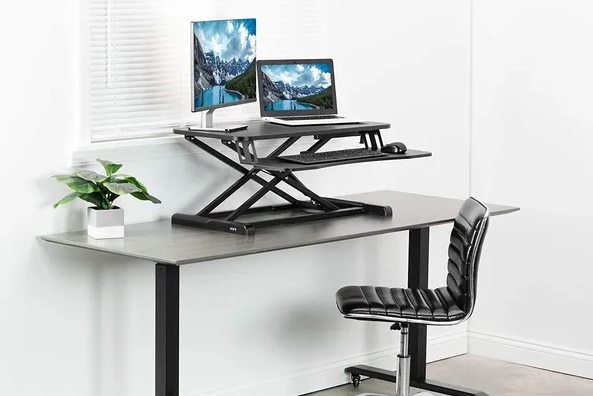When you consider everything, you may feel as though you are being pressured to decide between your professional life and your physical well-being at times. In the form of the standing desk, thankfully, an ergonomic solution to the problems faced by the modern worker who is forced to spend their days seated at a desk may be found.
Recent years have seen a proliferation of research that has linked the usage of a stand-up desk regularly to reduced chances of obesity, diabetes, colon cancer and a wide variety of other major medical conditions. Moreover, because our work and leisure lives revolve more and more around screens, sit-to-stand desks have become a crucial component of every house and office concerned with their inhabitants' health.
One of the most significant advantages of using a standing desk is that it is significantly better for one's health to stand all day instead of sitting for eight hours straight. Therefore, being able to burn calories by using a standing desk is a reasonable compromise for being on your feet for the entirety of the workday for the vast majority of people. But do people find that they burn more calories working at standing desks?
At this time, scientific evidence is everywhere and has reached the stage where it can no longer be disputed. However, unfortunately, we spend far too much time sitting, both at work and at home, which is hurting both our bodies and our minds.
According to recent research, even engaging in regular physical activity might not be enough to offset the risk to one's health by sitting for extended periods daily.
Because Dr James A. Levine of the Mayo Clinic once referred to sitting as a "lethal activity", and because the most in-demand positions of today need hours upon hours of face time in front of a computer screen, the situation may appear to be hopeless.
Workers today burn fewer calories while on the job than their predecessors did in previous decades. The primary reason is that many of the better jobs available in this information age require workers to remain seated in front of a stationary computer screen for the entirety of the workday.
According to their research, there is a one-to-one relationship between a person's annual pay and the time spent sitting at a desk performing their job duties.
First Things First: What Is A Calorie?
Unfortuitously, calories are not something you can extract from your food, like removing raisins from potato salad. Instead, the quantity of energy contained in food can be measured using a unit of energy called a calorie.
Kilocalories are another name for the "calories" that most of us are familiar with from reading nutrition labels. Kilocalories are written on food packaging. It takes one kilocalorie of energy to raise the temperature of one kilogramme of water by one degree Celsius. Hence the term "kilocalorie" refers to this quantity of energy. Continue reading.
Despite their unsavoury reputation, calories from food contribute positively to our health. They give us the fuel to keep ourselves healthy and active, which is the necessary energy our bodies need to function properly. On the other hand, if you consume more calories than you burn off through physical activity, the excess calories you ingest will be stored as fat in your body.
Because of this, maintaining our long-term physical, emotional and mental health requires eating a balanced diet and engaging in regular activity consistently.
How Long Should You Stand At A Standing Desk?
In the office, you should try to stand for at least one hour for every one to two hours you spend sitting. Make it a point to switch between sitting and standing at 30 to 60 minutes intervals. In a nutshell, you should try to switch between sitting and standing at regular intervals.
According to the findings of certain studies, standing causes a greater expenditure of calories than sitting does. This finding may help to explain why more people are using standing desks in today's offices. On the other hand, most of those studies focused only on one activity at a time (sitting or standing). The current study team reasoned that most people were engaging in many tasks at once or performing the activities in a different order, and they concluded that this was an important topic to investigate.
To achieve this goal, they solicited the help of seventy-four young and physically fit individuals to participate in a series of trials that had been meticulously planned out. At the beginning of the experiment, the volunteers were split up into four groups and instructed to sit, stand, or walk in varied patterns.
The first group members took a seat in front of a computer, typed for fifteen minutes, and then got up. The second participant walked on treadmills for fifteen minutes after sitting and watching television. The third group strolled around before sitting down, whereas the fourth group stood before sitting. According to Creasy, between each exercise, there was a three-minute "transition" period in which the participant "was seated at rest, not fidgeting and just relaxing".
Does A Standing Desk Count As An Exercise?
There is little evidence that is simply standing at work improves cardiovascular health. It is in contrast to activities such as jogging and cycling. Standing does not count as exercise. The most recent findings in the scientific community point to the idea that a lack of exercise and not sitting for long periods at work, maybe the primary cause of general poor health.
Why Do People Disagree About The Calories Burned By Standing At Desks?
The number of calories you can expend by standing as opposed to sitting has been the subject of hundreds of additional research. The findings, however, have been quite inconsistent due to the great variety of research subjects and scientific approaches utilised in the many investigations.
One consistent finding throughout all the research: spending hours upon hours of our lives passive is one of the worst things we can do to our bodies. Sitting for long periods is detrimental to our health and should be avoided whenever possible.
However, while it is undeniable that standing burns more calories than sitting, there has been much debate on the exact number of calories expended when standing as opposed to sitting. In addition, several studies widely reported on the topic have been called into doubt or invalidated because they had a narrow scope, a small sample size, or a lack of controls.
A study conducted at the University of Iowa in 2015 and was extensively reported indicated that workers who used adjustable standing desks stood for an average of one hour more per day than their colleagues who exclusively sat. In addition, these individuals burned an average of 87 more calories per day.
Many people interpreted the findings to indicate that sit-stand workstations burn 87 calories an hour. On the other hand, a significant portion of those additional calories burned was because people who used stand-up desks also walked an average of six minutes more per day while at work compared to those who used a conventional, non-ergonomic sit-down desk.
Walking burns more than twice as many calories as sitting or standing does, so standing desks should get some credit for their ability to motivate workers to move around and give them more energy.
How Do The Calories Burned By Sitting And Standing At Desks Compare To The Calories Burned By Other Activities?
According to a study published in Circulation, burning approximately 20 calories in fifteen minutes while sitting at a desk is equivalent to burning approximately 22 calories in fifteen minutes while standing at a desk.
Sleeping or sitting inactively burns fewer calories than either working while sitting or standing at the same time. So how do they stack up against other activities, such as gardening, cooking or even hopscotch with your children? Take a look at this.
The following is a rundown of the average number of calories that you can burn in fifteen minutes by participating in a variety of different physical activities:
- Sleeping: 11.5 calories
- Watching television when sedentary burns 18.66 calories
- 19.63 calories per hour of sitting and working
- Calories burned while standing and working: 21.92
- 55.9 calories you can burn by walking
- Skiing downhill or waterskiing burns 111.5 calories per hour
- Calories burned to play basketball: 149
- Depending on your speed, running can burn anywhere from 100 to 200 calories every mile
The findings presented above for walking, sitting and standing were taken from an investigation published in Circulation. The other totals, which were provided by the Harvard Medical School and represented the typical amount of calories burned by an individual weighing 155 pounds, were also provided.
Remember that these are simply averages and that the rate at which we burn calories varies greatly depending on factors such as our size, metabolic rate and gender. For instance, due to the differential in muscle mass, men still burn approximately two times as many calories as women standing still do.
How Can You Increase The Calories That You Burn At A Standing Desk?
As we have seen, standing rather than sitting while working burns more calories than sitting. However, the difference in the amount of energy spent by the two is insignificant compared to the energy consumption of other physical activities.
There are many different ways to boost the calories you burn when working at a standing desk without interfering with your productivity.
Don't Be Afraid To Fidget
Ignore everything your parents and school have ever told you about sitting (or standing) still if you want to give your calorie burn a little bit of an extra boost to lose some weight.
Yes, it has been found that fidgeting benefits our bodies' health. For example, fidgeting while at your computer burns more calories than standing perfectly still at your desk, according to a study published not too long ago.
When you are standing, the positive effects of squirming regularly become even more apparent. For example, when people are standing and fidgeting, they burn an additional 30 calories per hour compared to sitting and fidgeting simultaneously.
Shift around in your seat, twitch whenever you get the chance, and twiddle as if your life relies on it since regular movement keeps the blood flowing and the calories burning.
Get A Mini-Exercise Trainer
You are no longer required to choose between working at your desk all day and getting in your aerobic workout.
You can burn additional calories at your workplace by using a small-sized workout trainer, regardless of whether you are seated or standing at your desk. You could, for instance, use a small cycling machine that allows you to bike while seated and a small elliptical machine that allows you to get your steps in a while standing.
Stretch Regularly To Stay Loose
First, perform a series of calf raises and leg raises while seated. Then, while standing, perform a series of deep knee bends or lunges. You won't have any trouble standing at your desk for several hours a day if you keep your muscles flexible and loose so that you don't tyre out.
Take Regular Short Breaks
People who work at desks should get up from their seats every thirty minutes to stretch their legs and move around for a couple of minutes. So get up from your desk at least once every half an hour and move around. Consistent movement is the best present we can offer ourselves, so make sure you take advantage of this opportunity.
Use A Calorie Counter
Find a calorie counter that you can use online or a fitness app on your phone, and log the number of hours you spend sitting and standing daily. Not only will this tell you how many calories you burn when standing, but it will also serve as a helpful reminder to alternate between sitting and standing throughout the day.
Do Chair Exercises
Find a chair aerobics workout and start working up a good sweat if you aren't embarrassed about turning your workplace into an Olivia Newton-John music video. Your workout will benefit tremendously from adding a strong and supportive ergonomic chair. Click on the site.
Upgrade To A Standing Desk
Nevertheless, if you believe that those extra 100–200 calories an hour might help you attain your weight loss and that every little bit helps, then you should consider upgrading to a standing desk to shed some additional weight. Standing up as you work can be a bit of an adjustment at first, but once your body is adjusted to it, it can start to help you burn some extra calories.
Please find the best standing desk for you to use to maximise the calories you burn while working, supplement it with some exercises and other forms of physical activity, and then take it easy. At the same time, you see the number on the scale fall. Who among us doesn't look forward to that moment every time they step on the scale?
Do standing desks help weight loss?
Standing desks won't make you lose weight, and they also don't make you significantly healthier or more productive, according to a new analysis of 53 sit-stand desk studies.
How many extra calories do you burn with a standing desk?
According to the new study, standing only used a whopping two extra calories on average. That translates to an extra 8 to 10 calories for every hour on your feet. However, the difference was not statistically significant—and it's probably not enough to affect your weight, says study author Seth Creasy, Ph.
Are standing desks healthier?
More calories burned: One study showed that standing sheds 88 calories an hour, compared to 80 calories for sitting. Walking burns a lot more -- 210 calories an hour. Less back pain: Sitting for long periods tightens your muscles and can hurt your lower back, especially if you have a bad posture.
Are standing desks good for gaming?
Standing offers proven physical benefits that include reduced back, neck, and shoulder pain, improved blood circulation, increased energy expenditure, and better posture. These should all lead to healthier and happier gamers.
Should you use a standing desk all day?
Sitting behind your desk all day is bad for your health, and experts have long been advising people to stand at their workstations for about 15 minutes an hour. But a University of Waterloo professor says his research shows that people should be standing for at least 30 minutes per hour to get health benefits.



